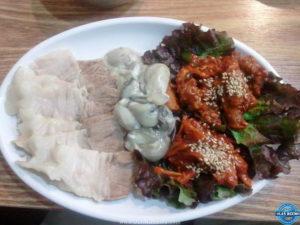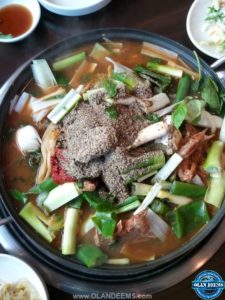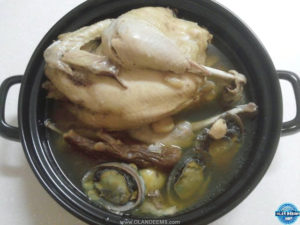Unveiling South Korea’s Most Delectable Dishes (Part 2)
South Korea is known for its rich culinary traditions and flavorful dishes. From savory grilled meats to spicy stews and pickled delights, the country offers a wide variety of mouthwatering options. Here are some of the best-tasting South Korean dishes that are sure to leave you wanting more.
1) Bossam: A Flavorful Ensemble of Korean Delicacies

Bossam (보쌈)
Bossam stands out as a cherished culinary tradition in Korean cuisine, showcasing the rich flavors and unique serving styles that Korean food is known for. This dish centers around belly pork, which is boiled in a blend of spices until tender and then thinly sliced to reveal its succulent texture. Bossam is not just about the pork; it’s a complete meal that involves an array of complementary side dishes, each adding its own flavor and texture to the main ingredient.
The preparation of Bossam involves simmering the pork in a carefully selected mix of spices, which infuses the meat with deep, aromatic flavors while ensuring it remains juicy and tender. Once cooked, the pork is typically cooled and sliced into bite-sized pieces, ready to be wrapped in a variety of fresh vegetables.
The real magic of Bossam lies in its accompaniments. It is traditionally served with a spicy radish salad, which offers a crisp, tangy contrast to the rich pork. Sliced raw garlic and ssamjang (a flavorful Korean wrap sauce made from fermented bean paste and chili paste) are essential for adding a punch of flavor. Saeu-jeot (salted shrimp) and gul (oysters) are often included to enhance the dish with a hint of the sea. Kimchi, with its spicy and sour notes, is another indispensable side that complements the fatty pork beautifully.
Diners enjoy Bossam by wrapping a slice of pork and a combination of these side dishes in ssam vegetables like lettuce, kkaennip (perilla leaves), or the tender inner leaves of napa cabbage. This method of eating not only makes Bossam a delightful experience but also allows each diner to customize their wrap with the flavors they love the most.
Bossam embodies the communal spirit of Korean dining, encouraging sharing and interaction at the table. It’s a dish that brings people together, offering a delicious exploration of flavors and textures that make Korean cuisine so beloved. Whether enjoyed at home or in a restaurant, Bossam is a festive and flavorful feast that satisfies the soul.
2) Gamjatang: A Hearty Staple of Korean Comfort Food

Gamjatang (감자탕)
Gamjatang, translating to “potato stew,” is a robust and spicy Korean soup that is as comforting as it is flavorful. Despite its name, the star of the dish is not just the potatoes but also the pork back-bone or neck bones, which are used to create a deeply savory and rich broth. This traditional soup is a favorite in Korea, often enjoyed for its hearty qualities and its ability to bring warmth and satisfaction.
The preparation of Gamjatang begins with the pork bones, which are boiled to perfection to extract maximum flavor. This process not only tenderizes the meat but also infuses the broth with a rich, meaty essence that forms the base of the soup. Potatoes, another key ingredient, are added for their comforting texture and ability to absorb the flavors of the broth.
A distinctive feature of Gamjatang is its vibrant array of additions that enhance both its texture and taste. Cellophane noodles, known for their delightful chewiness, are a common inclusion, along with dried radish greens that offer a slight bitterness to balance the richness of the meat. Perilla leaves contribute a unique aroma and minty flavor, while green onions and hot peppers add freshness and a kick of spice, respectively. Ground sesame seeds are sprinkled on top as a finishing touch, providing a nutty, earthy flavor that complements the soup beautifully.
Gamjatang is typically enjoyed with a side of rice and a variety of Korean side dishes, known as banchan. The communal aspect of sharing Gamjatang, paired with its spicy and warming qualities, makes it a popular choice for family meals and social gatherings, especially during the cooler months.
As much as Gamjatang is a celebration of flavors and textures, it is also a testament to the Korean philosophy of using whole ingredients and minimizing waste. By utilizing the pork bones, this dish exemplifies the sustainable practices inherent in Korean culinary traditions, making it not only delicious but also a respectful nod to nature’s bounty. Whether served in a humble home kitchen or a bustling restaurant, Gamjatang remains a beloved part of Korea’s culinary heritage, offering comfort and joy to those who partake in its hearty embrace.
3) Samgyetang: Korea’s Nourishing Ginseng Chicken Soup

Samgyetang (삼계탕)
Samgyetang, a comforting and nutritious dish, translates to ginseng chicken soup in Korean, encapsulating the three core elements of the dish: ginseng (삼), chicken (계), and soup (탕). Revered not just for its delicious taste but also for its health benefits, Samgyetang is particularly popular during the hottest days of summer, believed to help replenish energy and boost vitality according to the principles of Korean traditional medicine.
At the heart of Samgyetang is a whole young chicken, typically a poussin, which is prized for its tender meat. The chicken is stuffed with a flavorful mixture of garlic, rice, jujube (Korean dates), and ginseng. This combination not only imparts a rich depth of flavor but also infuses the broth with a myriad of health benefits. Ginseng, the star ingredient, is renowned for its properties that aid in improving stamina and fighting fatigue.
The preparation of Samgyetang involves simmering the stuffed chicken in a clear broth until the meat is fall-off-the-bone tender. As it cooks, the flavors of the garlic, jujube, and ginseng meld together, creating a harmonious blend that is both subtle and complex. The rice inside the chicken absorbs the flavors of the broth, becoming a deliciously infused accompaniment to the meat.
Served steaming hot, Samgyetang is often enjoyed with nothing more than a sprinkling of chopped green onions and a pinch of salt to taste. It’s a simple dish, yet its simplicity belies the rich and satisfying experience of each spoonful. The broth is light yet nourishing, and each ingredient plays a crucial role in building the soup’s rejuvenating qualities.
Samgyetang is more than just a meal; it’s a cultural experience that embodies the Korean ethos of food as medicine. Whether one seeks comfort, nourishment, or a light yet fulfilling meal, Samgyetang offers a delicious solution that has been cherished across generations in Korea. It’s a dish that not only fills the stomach but also soothes the soul, making it a beloved choice for both everyday dining and special health-conscious occasions.
From the spicy and tangy flavors of kimchi to the savory delights of bulgogi and bibimbap, South Korean cuisine offers a wide range of mouthwatering dishes. Whether you’re a fan of grilled meats or prefer vegetarian options, there is something for everyone to enjoy. So, the next time you find yourself in South Korea or at a Korean restaurant, make sure to try these best-tasting dishes for an unforgettable gastronomic experience.











